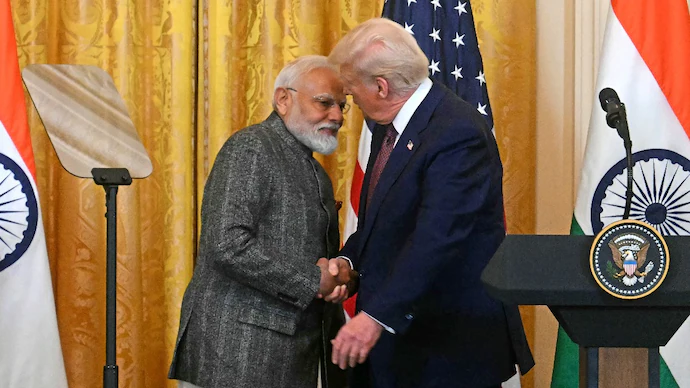The “Mission-500” between India and the USA aims to boost trade of 500 billion $ between two countries and strengthen strategic partnership for mutual benefits until 2030.

The present piece of writing is a dare attempt to analyze the long-lasting romance between the two democracies the USA and India with the futuristic perspective under the Trump regime 2.0. From the ex-post facto lenses, the cold war power politics has witnessed the in-depth estrange relations between India and the USA.
The alliance politics, India’s Non-alignment (NAM) dogma, Nehru’s slogan of “Asia for Asians”, American inclination with Pakistan, the inaugurations of SEATO & CENTO defense pacts, de-colonization, USSR and USA rift, arms race, nuclearization, India-Pakistan rivalry and arms race, soviet invasion, military assistance to Pakistan were the main Pandora box for the India as well as the reasons behind the estrange ties of India and the USA while explaining their relations.
Soon after the disintegration of the USSR, the paradigm shift occurred in global power politics and the states tried to search for new partners, alliances and new markets. With liberal economic reforms, the biggest demographic market, investment opportunity, strategically closeness with the Indian Ocean and SLOCs, India got importance in the eyes of the west. Apart from the Indian undeclared nuclear efforts and finally nuclear explosions of 1998, not joining of NPT and other nuclear non-proliferations as well as disarmament club, India was still favorite for the West.
The 9/11 terrorist attack, Bush’s war on terror and Indian inclination with the USA against terrorism and particularly China’s rise in the eastern hemisphere, raised New Delhi’s significance in pentagon south Asian diaries. The Gsomia-2002 NSSP-2004, Defense framework-2005, Nuclear deal-2008, DTTI-2012, Lemoa-2016, Comcasa-2018, ISA-2019, BECA-2020 and lastly defense deal-2020 between India and the USA during trump visited to India give a prominent signal regarding India’s prominence for America’s CENTCOM foreign policy.
During Biden’s era (2021-2024), the American involvement in south Asian affairs as well as wider indo-pacific was very limited. It seems that no particular development occurred in India-US relations.
Moving forward, this time the Trump action-reactions syndrome while dealing with global politics and challenges are different as compared to his previous presidency tenure. This time the maturity and understating to deal with the global politics and challenges seem high.
Apart from the initial executive orders and press release, the invitation for Modi to visit the USA can be paradoxical in nature. Trump’s strict immigration policy and deportation of Indians from the USA territory can raise the ambiguity and vagueness in the relations but the Indian diaspora in the USA have ability to handle it. Approximately, the 4.8 million population with Indian origin are living in the USA and it is really a massive number of diaspora living abroad and can blossom or bottom during the presidential elections.
Therefore, the Indian diaspora has very in-depth impacts on America’s any foreign policy moves towards South Asia generally and particularly towards India and Pakistan. Not only diaspora, the Indian intellectuals in American universities and colleges, multinational companies i.e., Google, Microsoft and others are the symbol of 21st century Indian wisdom rising in the American capitalist market.
By following the economic context, without any doubt, India will be the favorite trade market for the Trump administration as like the previous presidents. India is a finest trading partner of the USA. Under the “Misson 500” and following the dogma of America’s MAGA (Make America Great Again) and India’s MIGA (Make India Great Again), Modi and Trump has launched the initiative named “MEGA partnership-2025” and this would be another milestone for two countries relationship as like NSSP-2004. The following chart represents the trade volume in goods between India and the USA in the year of 2024.

Strategically, Trump administration still remember their strategically goals including counter china via powering India, tariff wars, trade war, powering the Asian alliances and re-inaugurating the indo-pacific security theater, significance of QUAD, AUKUS and Blue dot Network. India’s defense trade with the U.S. has witnessed a remarkable transformation, which is near to $20 billion.
The growing defense cooperation is a signal of securing common geopolitical interests in the Indo-Pacific vista. The two countries announced an agreement to put the U.S.-India COMPACT (Catalyzing Opportunities for Military Partnership), this framework aims to institutionalize a defense-industrial cooperation agenda and underpinning co-production and co-development endeavors.
The arms trade will be the cornerstone for two countries aim to counter china rise in the eastern hemisphere. Under the “Mission 500”, the trade will boost. Moreover, India will get F-35 fighter jets, C-130J Super Hercules, P-8I Poseidon maritime patrol aircraft, C-17 Globe-master III transport aircraft, , CH-47-F Chinooks, AH-64-E Apache helicopters, M-777 howitzers and Harpoon anti-ship missiles. The reason for purchasing these advanced weapons is the rising Chinese threat for the USA and India respectively in the wider Indo-pacific.
China will be the main competitor for the Trump administration and this is the main reason behind the Indian admiration. Moreover, both countries agreed to inaugurate the initiative titled “Reciprocal Defense Procurement (RDP)” very soon.
Trump will support India in its Neighbored policy (Act East Policy) towards east and promote Indian valuable contribution in QUAD as well. In the era of artificial intelligence AI, India and the USA have announced India-US “TRUST” (Transforming the Relationship Utilizing Strategic Technology) initiative with the aim to increase collaboration in public private partnership, public engagements, education engagements, AI sector and cyber-security learnings.
Politically, it would be an equivocal strategy regarding the USA supporting the Indian dream to get a UNSC seat. There will be paradox moves of the USA while dealing with India in this matter.
By crawling towards the terminus, truly, India is necessitated for America while dealing with Asian matters. With the nuclear capabilities, advance weapons and missiles, near to Indian Ocean, strategically important, near to China and powerful dogma in south Asia, India is the first choice for the pentagon. The Pentagon knows well India’s strategic importance in the Asian region.
The USA considers India as a counterweight power against any threat to American interests in the Asian region. On the contrary, the American policy makers should remember the words “There are no permanent friends and enemies in International relations, just as today’s ally can become tomorrow’s enemy” and sometimes a friend who turns into an enemy can be far more dangerous and fatal.
Author: Rana Danish Nisar – Independent international analyst of security, defense, military, contemporary warfare and digital-international relations.
(The views expressed in this article belong only to the author and do not necessarily reflect the views of World Geostrategic Insights).







